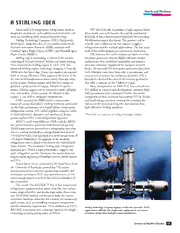
NASA Technical Reports Server (NTRS) 20020064621: A Stirling Idea PDF
Preview NASA Technical Reports Server (NTRS) 20020064621: A Stirling Idea
Health and Medicine A STIRLING IDEA Super cool! Low temperature refrigerators, medical STC has been able to produce a high-capacity linear diagnostic equipment, and sophisticated electronics—all drive cooler, one with features that satisfy commercial these are benefiting from cryocooling technology. demands. It has a demonstrated operation life exceeding Stirling Technology Company (STC), Kennewick, 30,000 maintenance-free hours. The product will be Washington, designed a line of cryocoolers under Small initially sold to laboratories that require cryogenic Business Innovation Research (SBIR) contracts with refrigeration and for medical applications. The low noise Goddard Space Flight Center (GSFC) and Marshall Space level of the cooler permits its operation in work areas. Flight Center (MSFC). STC believes that niche markets are likely to evolve Stirling engine technology is rooted in the creative for power generators that are highly-efficient, reliable, tinkering of Scottish brothers, Robert and James Stirling. maintenance-free, multifuel compatible and produce They invented the Stirling engine in 1816. STC has ultra-low emissions. Supported by company research advanced Stirling engine technology, bringing it from the funds, 10-watt and 350-watt power generators have been 1800s into the Space Age. These type engines are unparal- built. Multiple units have been sold to government and leled in energy efficiency. They approach the limits set by commercial customers for evaluation purposes. STC’s the laws of thermodynamics more closely than any other forecast is a demand for turn-of-the-century generators power system. Stirling engines need less heat energy to that offer a capacity in the 3-kilowatt range. generate a given power of output. Versatile in perfor- Since incorporation in 1985, STC has received over mance, Stirling engines can be reversed to make refrigera- $22 million in research and development contracts from tors, cryocoolers, or heat pumps. So efficient is the both government and commercial clients. Successful engine, it can chill to cryogenic temperatures. completion of these contracts has enabled STC to design GSFC awarded the SBIR funds to characterize and build unique products, earning the company the spacecraft sensor/instrument cooling hardware, predicated reputation for providing long-life, maintenance-free, on the high performance of a liquid helium temperature high-efficiency Stirling machines. refrigeration system. STC culled together company talent in thermodynamic, dynamic, and mechanical design, ™BeCOOL is a trademark of Stirling Technology Company. producing for GSFC a low-temperature approach. MSFC’s needs were different. SBIR work for MSFC was geared toward a spacecraft food freezer/refrigerator. NASA requirements centered on a refrigerating unit that ran at a cooling potential or average freezer heat load of 115 thermal watts, and operated at a chilly temperature of -15 degrees Fahrenheit. An upgrade of the modular refrigeration unit is slated to be aboard the International Space Station. The innovative Stirling cycle refrigerator approach gave NASA a high performance, rugged, and quiet refrigerator system. Moreover, the system does not require ozone-depleting chlorofluorcarbons, better known as CFCs. A new linear motor, invented by Dr. Syed Nasar from the University of Kentucky, proved key. The motor accommodated low-cost mass production assembly and fabrication techniques. STC tests and refinement of this motor design proved crucial in the commercialization of the cryocoolers. The result? The BeCOOL™ line of low temperature refrigeration equipment that sports long life, low mainte- nance, high reliability, and attains high safety characteris- tics. All of these features combined to make the newest cryocooler hardware attractive for a variety of commercial applications, such as controlling computer temperature and for laboratory experiments. These attributes of STC’s Stirling Technology Company engineer readies the cryocooler. NASA BeCOOL cryocoolers have a heritage based in the tough, requirements called for low-temperature equipment to run sensors technology-pushing prerequisites of NASA. to achieve refrigeration levels for a space-rated freezer. Commercial Benefits—Spinoffs 53
